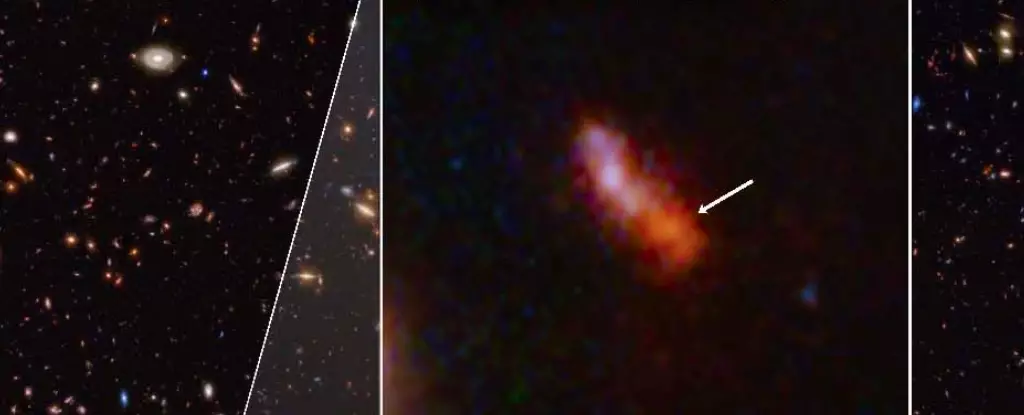The astronomical community is buzzing with excitement, thanks to the groundbreaking capabilities of the James Webb Space Telescope (JWST). Just when we thought we had gleaned an understanding of the cosmos in its infancy, the JWST has delivered yet another stunning revelation—light from the most distant galaxy ever detected, recorded a mere 280 million years after the Big Bang. This remarkable discovery doesn’t just scratch the surface; it delves deep into an era previously shrouded in mystery. With its immense 6.5-meter mirror and advanced infrared technology, the JWST is reshaping our definitions of galaxy formation and evolution.
Before the era of the JWST, we were limited to telescopes like Hubble and Spitzer, which lacked the necessary sensitivity and resolution to observe such ancient celestial bodies. Hubble couldn’t peer deep enough with its 2.4-meter mirror and could only locate one galaxy from the universe’s first 500 million years. Spitzer, primarily an infrared telescope, had a mere 85-centimeter mirror. The JWST, however, breaks through these barriers, ushering humanity into the depths of the early universe.
MoM-z14: A Window into Cosmic Antiquity
The newly identified galaxy, MoM-z14, emerges from the Mirage survey, which aims to robustly confirm high-redshift galaxy candidates. With a redshift of z=14.4, MoM-z14 marks a significant leap in our observational reach, pushing the frontier of understanding further back in time. Researchers, including lead author Rohan Naidu, express this discovery’s profound implications in submitted work titled “A COSMIC MIRACLE: A REMARKABLY LUMINOUS GALAXY AT zspec = 14.44 CONFIRMED WITH JWST.” This paper is not merely an academic exercise; it signals an expansion of our comprehension surrounding the genesis of galaxies in the universe’s early epochs.
What’s particularly striking is the unexpected abundance of bright galaxies that the JWST is uncovering at such high redshifts—greater than z=10. The community had anticipated that very few galaxies would have emerged so early, yet the JWST has rapidly turned that consensus on its head. Each new finding generates ripples of analysis and intrigue, leading to critical questions about the processes that governed early star formation.
Connecting the Dots: Chemistry and Evolution
Beyond just light and galaxies, the JWST has begun to illuminate patterns within preliminary galactic chemistry. The spectral analysis of MoM-z14 reveals that while this ancient galaxy undoubtedly hosts powerful star formations, the light it emits primarily comes from stars rather than an active galactic nucleus—those bright centers fueled by supermassive black holes. This suggests a fundamentally different evolutionary pathway for early galaxies than previously thought, where massive stars might well be the norm.
What also stands out in the findings is MoM-z14’s nitrogen-to-carbon ratio, found to be higher than that of the Sun. This elevates the possibility that the stars in this galaxy formed in conditions akin to those in ancient globular clusters associated with the Milky Way. The implications are tantalizing: we may be witnessing the formation of first-generation stars in dense clusters, offering a glimpse into the intricate connections that weave through cosmic history.
Furthermore, the morphological characteristics of early galaxies have begun to reveal intriguing distinctions. Two primary forms have emerged: point sources and extended galaxies. The relationship between these shapes and their chemical compositions opens up new avenues for understanding the very nature of galaxy evolution.
A Bright Future for Cosmic Exploration
As the JWST continues to push beyond the limits of our previous observational capabilities, it seems that the chase for ancient cosmic bodies is far from over. Each discovery invites further analysis and challenges accepted notions, reinforcing the idea that the universe is far richer and more complex than we dared to imagine. The capabilities of the JWST herald a new era in astronomy, where the long-awaited examination of the early universe is not just a dream but a burgeoning reality.
In addition to MoM-z14, astronomers are beginning to recognize a class of objects defined by their strong nitrogen emissions, including the newly coined “Little Red Dots.” These findings hint at a profound bimodality in size and chemistry among galaxies at z > 10. As observations from the JWST unfold, they seem to converge upon a narrative that connects the burgeoning landscape of ancient galaxies with the evolutionary pathways we see today.
Awaiting further insights, astronomers earnestly anticipate the potential contributions from the upcoming Roman Space Telescope. This larger dataset will undoubtedly complement JWST’s findings and perhaps unravel even more complex narratives surrounding galaxy formation and evolution.
In the grand tapestry of cosmic history, the James Webb Space Telescope is not just a tool; it’s a lens through which we can look back in time and start to sketch out the outlines of our universe’s origins. With the JWST at the helm, the line between mystery and comprehension continues to blur, promising a future ripe with exploration and discovery.


Leave a Reply